Project 68 Chapayev class cruisers (1941)
 5 cruisers (1941): Chapayev, Zheleznyakov, Kuybyshev, Chkalov, Frunze
5 cruisers (1941): Chapayev, Zheleznyakov, Kuybyshev, Chkalov, Frunze
The Chapayev class cruisers were a continuation of Soviet cruiser design of the 1930s. Although USSR was not a signatory of the Washington treaty in 1921, the naval staff was well aware of the developments of the time, in the West and Japan as well. The Kirov class, an in-between light and heavy cruiser type, was the original solution of a universal cruiser for mass production, that proved flawed. After the treaty of London in 1930, confirmed in 1935, the new direction taken by navies was to create 10,000 tonnes light cruisers, as the 8-in category was now capped. USSR was no exception to this and started planning a new generation of large 6-in cruisers.
This design followed the Maxim Gorky class (1938, comp. 1943), and were largely improved, by their size, with the addition of 5,000 more tons allowing room for armour improvements, secondary artillery and AA. They were in fact the first Soviet cruisers designed completely out from Italian influences started with the two Kirov of 1935. However their construction was caught by the German invasion of 1941. The most advanced were evacuated for a later completion, and the last two were captured and scrapped by the Germans. Due to their post-war completion they became the first of the last wave of conventional cruisers in the USSR, abandoned after the death of Stalin in 1953, succeeded by the Sverdlov.

wow, Top view of the Project 68
Design Development of Project 68 Чапаев
The tactical and technical assignment (TTZ) for the design of a new cruiser (“Kreiser”, abbreviated KRS) was developed from 1936, by taking into account a change of naval doctrine which defined the main combat missions for cruisers in an oceanic role. A significant influence came from the main artillery revision and auxiliary caliber, which were to be specially created for the new class. With a standard displacement of 8000-8300 tons, composition of the armament was determined soon, three triple gun turret of the MK-5 mount type, housing 152-mm (6-in) caliber guns of the type B-38. This was completed by four twin mounts type B-54 turrets, 100-mm universal (dual purpose) caliber guns. It was completed by six twin 37-mm 66-K AA guns. Protection needed to include a belt thickness of 100 mm, 50 mm armored deck, and a citadel offering protection from 152-mm shells in order to expand the area of evolution within hitting distance, the immune zone against enemy’s armor-piercing shells. Top speed was to be maintained at 35 knots. Compared with the previous project “26-bis” Gorky class (Laid down December 1936), Project 68 had a much enhanced armor protection, with better cruising range and autonomy in accordance with the conditions of the North and Pacific theaters, while composition and layout of the powerplant was to that of project “26-bis”. Later, project 26-Bis2 was started, with the Kalinin class, laid down at Amur Shipbuilding Plant, Komsomolsk-on-Amur in August 1938.
Development of project 68 really started at the Leningrad Central Design Bureau-17 (TsKB-17) in 1938. Technical design was approved by a decree at the Council of People’s Commissars in July 13, 1939, followed by orders placed to various yards. Development of a preliminary design at TsKB-17 (Leningrad) was headed by A. I. Maslov. The project defined a new type of oceanic cruiser, using part of the Project 26-bis base. The main caliber of 152 mm had a smaller mass and dimensions which, which, by combining a larger hull allowed enhance armor protection, as well better fuel capacity and habitability. To increase the efficiency of the steam turbine engines, maximum power was slightly reduced at the expense of the maximum speed. Shipbuilders NN Isanin, AS Savichev, NA Kiselev, GA Gasanov participated in the development, and the estimated displacement shifted from 8300 to 9500 tons to be more realistic. The Navy staff however estimated a nearly 10,000 tonnes cruiser needed a fourth aft main-caliber turret, to be better aligned with foreign constructions, like the British Town class, American Brooklyn class or Japanese Mogami class (which even had five). The approved Resolution of July 13, 1939 accepted a total light displacement of 10 620 tons, up to 13 330 tons normal, with a lenght of 199 meters and a width of 18.7 meters and 5.9 m at normal dislpacement, plus a metacentric height of 0.89 m.
Design
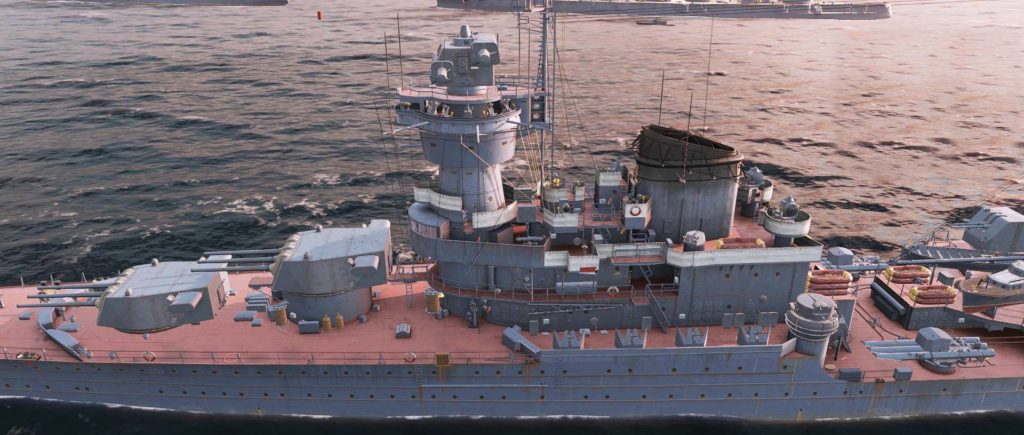
wow’s rendition of the Chapaev, front section view
Power plant
The ensembles of boiler-turbine occupied eight compartments in the middle of the hull, in two autonomous echelons. They included in all 6 main water-tube boilers of the KV-68 type (oil fired) and two main turbo-gear units (GTZA) of the TV-7 type for a total capacity of 110,000 liters and four turbo generators of 300 kW each, plus two diesel generators of 250 kW each for the all-electric systems onboard. Total power as rated was 124 600 shp (91 580 KW). By comparison, the previous class had 6 Yarrow-Normand water-tube boilers and 2 geared steam turbines rated for a total of 113,500 shp (84,600 kW), and a top speed of 36 knots, whereas the Chapayev class had a top speed of 33.5 knots (62.0 km/h; 38.6 mph). This slight decrease was compensated notably by a better reliability, and overall a much better radius of action, worthy of “oceanic” type cruisers: 7,000 nmi (13,000 km; 8,100 mi) at 19 knots (35 km/h; 22 mph) versus 3,750 nmi (6,940 km; 4,320 mi) at 18 knots for the previous Gorkiy class. The Chapayev carried 3,500 short tons of oil fuel.
Protection
In comparison with the previous project 26-bis, the armoured scheme was much improved.
-Armor belt: 100 mm (4-in) instead of 50 mm
-Bulkheads: Forward: 120 mm, aft: 100 mm (5-in) instead of 50 mm
-Main artillery barbettes: 130 mm (5.5 in) instead of 50 mm
-Turrets face: 75 mm (3.0 in) instead of 70 mm
-Conning tower: 150 mm (5.9 in) as before
-Armored deck: 50 mm (2.0 in) as before
In general, the previous design was vulnerable even to destroyer artillery, whereas the new design had an immune zone against 130 mm calibers.
The wheelhouse was protected by bulletproof armor 10 mm thick. Total Armor weight represented 22% of the standard displacement or circa 2910 tons, 1.85 times more than on the USN Cleveland class at the time. Structural underwater protection was absent, to the exception of a double bottom, but transverse bulkheads divided the hull into 23 main watertight compartments. As for the previous class, speed was estimated a good enough active protection.
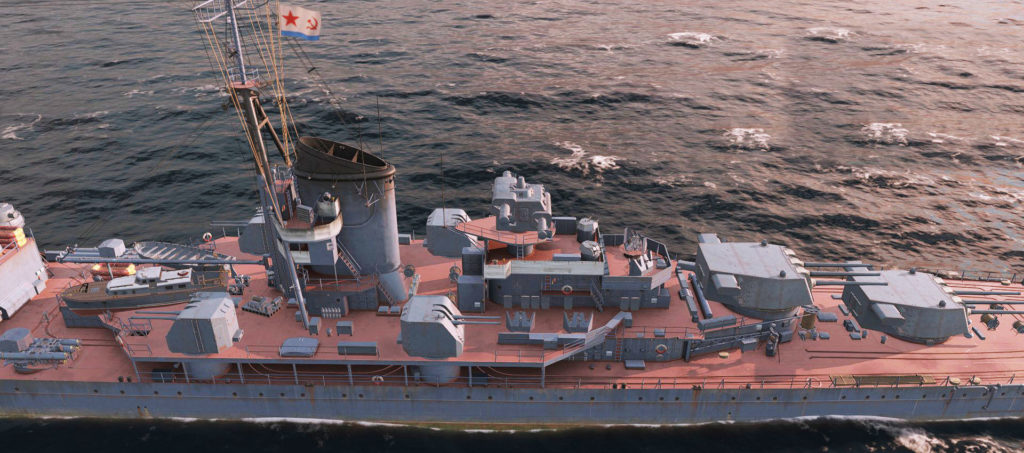
wow’s rendition of the Chapaev, aft section view
Armament
The approved final composition included four main caliber artillery mounts of the type MK-5 (4×3) 6-inches, four auxiliary type B-54 DP mount, six twin type 66-K AA mounts and a complement of four twin 12.7 mm heavy machine gun mounts. The initial torpedo armament comprise two triple 533 mm torpedo tubes (21 in), and provision was made for one catapult and two KOR-2 reconnaissance and spotting seaplanes.
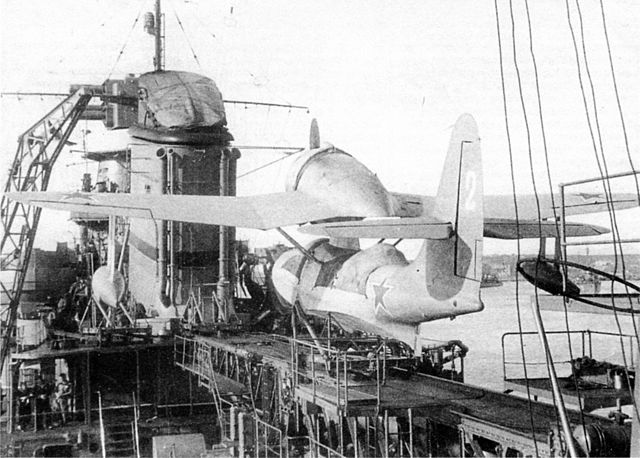
Main guns
The 152 mm/57 (6″) B-38 Pattern 1938 was originally developed for the Sovietky Soyuz class Battleships planned in 1937, and later was declined for the new Chapayev class but did not enter service until 1949. According to naval experts it was was a good, if not outstanding weapon.
Designed started at the “Bolshevik” factory in 1938 and the first gun production prototype was completed in 1940 and after tests, production started. By 1941 10 were available, used in further testings, and the remainder were used as railroad guns by installing on cradles reworked, originally made for 8 inches/45 (203 mm) guns.
There were four different turrets types designed for this gun and past the initial MK-4 (Sovetsky Soyuz class), the “cruiser type” was the MK-17, a lighter version designed for the Kronshtadt class battlecruisers while the MK-5 was a triple turret designed for the Chapayev and Sverdlov classes. The MK-9 was intended for the modified Sovetsky Soyuz class, also cancelled.
The total weight of the gun was 38,581 lbs. (17,500 kg) for an overall length of 351.8 in (8.935 m) and chamber Volume of 2,002 in3 (32.8 dm3).
Rate Of Fire was 7.5 rounds per minute, and the Chapayev class only carried 170 rounds per gun.
The Type 5 main guns, caliber 152-mm guns could fire either armor-piercing (AP), semi-armor-piercing (SAP), and high-explosive fragmentation (HE) shells, all weighing 55 kg, with an explosive charge A-IX-2 TNT 2% for armor-piercing shells to 11.4% TNT for the high-explosive fragmentation model. Maximum firing range was 30 215 m. These guns could also fire parachuted flares (48.5 kg) for illumination, and even ASW remote grenades 54.23 kg. The Soviets contrary to the Japanese never tried the radical shrapnell AA shot for AA fire.

Schematics of the Chapayev class in 1950 (Kombrig)
Secondary guns
The 100 mm (3.9 in)/56 model 1940, or 100 mm/56 B-34 Pattern 1940 guns resulted of the failed B-14 gun in 1935 at the “Bolshevik” factory. A revised prototype was made in 1937, modified, and restarted in 1938, and returned for more changes with final trials in 1939, yet failed again. As war started, the need for a heavy AA gun was such that mass production was ordered anyway, and by start of 1941, 42 guns were at hand, all crippled by issues. In 1941, an improved version called B-34-U was delayed until 1946 and 213 were manufactured by 1950. Notably the pneumatic-powered semi-automatic breech was replaced by a more reliable spring-powered semi-automatic breech, which didn’t fix all problems. Falling rounds of the breech and fuze setting problems persisted.
They were fixed on the B-34-USM designed in 1948, of which 114 were built until 1952, their mount modernized in 1953.
They were used notably on the Riga-class frigates and Don-class submarine tenders.
With the 1951 “Sfera-50” control system these guns could hit targets up to 35,000 yards (32,000 m) and jet aircraft.
Denomination “100 mm/56 Model 1934” found in Wikipedia and other sources is mostly incorrect.
On the Chapayev class, there were four twin mounts located abaft the aft funnel on the superstructure. They were capable of 15 rounds per minute, the mount weight 13.53 tons, cold elevate/depress at -8 / +85 degrees, with a 10 degrees per second traverse and 12 degrees per second elevation. Maximum range was 17,500 yards, effective range 10,900 yards (16,000/10,000 m), 24,323 yards (22,241 m) against surface targets with the 34.4 lbs. (15.6 kg) HE Shell. They fired a fixed round about 61.7 lbs. (28 kg) with propellant. There were three types of AA shells, the HE model 1928, a diving shell, star shell and anti-ECM shell. Outside the Chapayev, this gun was used in many other design, notably it was copied in China and equipped the Luhai, Luhu, Jiangwei and Jianghu classes well until the 1990s for some.
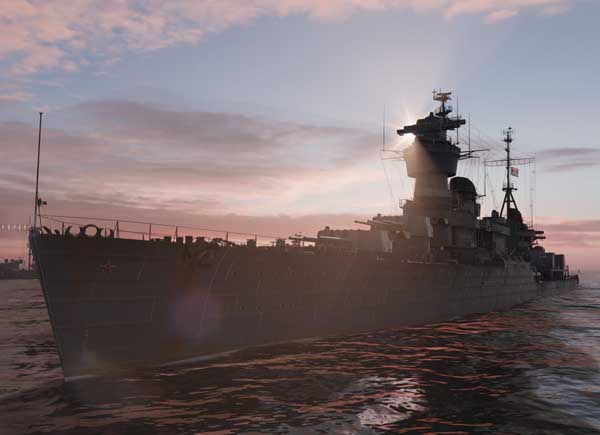
Electronics
Of course back in 1938, this was out of question. No provision was made for a radar and instead, a spotted plane was to be carried, as for the previous class (Project 26). Provision was made for a catapult, which was never mounted. Instead, the deign was revised before completion, as Project 69K, and improved over the years. The ships were given the following systems before decommission in 60-65:
Detection radars
-Main surface detection radar “Guys”
-Detection radar NTs, two “Rif” systems
-AA detection radar “Tamir-5N”
Fire control radars
-2 “Volley” for the main artillery
-2 “Anchor” (as part of SPN-500) for DP armament
C&C, rangefinder:
-2 KDP2-8-III for main battery
-2 SPN-500 for the DP 100 mm AA
Identification radar – “Fakel-MO/MZ”
Construction
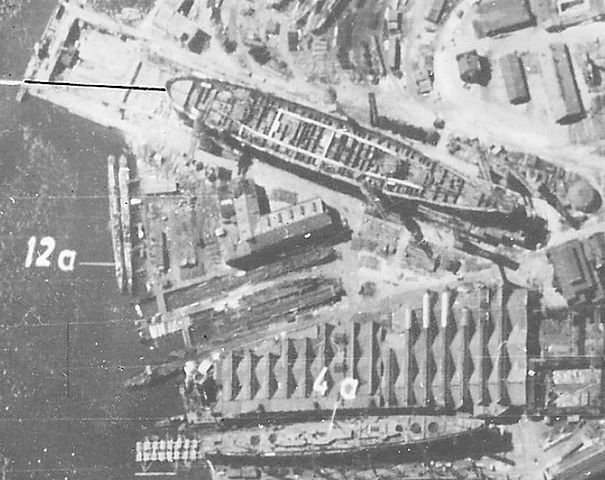
Baltic yard’s cruiser hull in construction, shot by the Luftwaffe on 26 june 1941
According to the ten-year plan for the construction validated by the RKVMF, in accordance with the development program of the oceanic fleet, by the end of 1947 it was planned to lay twenty-six more cruisers of the projet 68, including 17 ships integrated into the five-year plan FY 1938-1942. In reality, only seven cruisers were laid down in Leningrad and Nikolaev. Since the start of WW2, only 5 were launched, but completion was stopped and they were mothballed. Also two, Ordzhonikidze and Sverdlov, were not ready in time for launching and has been captured in Nikolaev by the Germans. They were dismantled under the occupation for scrap metal, only 20% complete by then.
In addition, it was planned to lay down five more cruisers in Soviet shipyards by August-December 1941, four of them already named. The same number was planned to be laid down in 1942, but the Great Patriotic War shattered these plans. It was decided to reaffect men and material to more urgent tasks, notably completing ships and maintenance of existing vessels. The 100-mm dual-purpose/anti-aircraft guns on paper matched or exceeded the allied pre-war artillery systems but development was rocky at best and reliability was achieved well into the 1950s. They would have however a long service life, covering most of the cold war, at least on the Chinese side. The 37-mm anti-aircraft gun were close in concept to the Bofors in terms of performance and characteristics, and were used in various occasions during the war. The following list details the ships’s construction status.
Completion was put on hold for the duration of the war, once the ships were safe of capture or destruction. The design was modified to include improvements, notably in radars and fire control systems, and naturally the catapult and spotter planes were removed as a result, as well as the torpedo tubes, now considered an obsolete feature.
Chapayev named after: Vasily Chapayev (Ordzhinikidze Yard, Leningrad), Laid down 8 October 1939, launched 28 April 1941, completed 16 May 1950.
Zheleznyakov Named after: Anatoly Zheleznyakov (1895-1919), Built by: Admiralty Shipyard (Leningrad) Laid down 31 October 1939, Launched 25 June 1941, Completed 19 April 1950
Kuybyshev Named after: Valerian Kuybyshev. Built by: Marti Yard (Nikolayev). Laid down 31 August 1939, launched 31 January 1941, Completed 22 December 1950.
Chkalov (later Komsomolets). Named after Valery Chkalov, Built by Ordzhinikidze Yard (Leningrad), laid down 31 August 1939, launched 25 October 1947, Completed 1 November 1950
Frunze Named after Mikhail Frunze, Marti Yard (Nikolayev), Laid down 29 August 1939, Launched 31 December 1940, Completed 15 December 1950.
Ordzhinikidze and Sverdlov were also ordered in 1938, but scrapped on the slipway after capture by the Germans in Nikolayev. Sverdlov was the name for the successor’s class.
Specifications
11,130 long tons (11,310 t) standard, 14,100 long tons (14,300 t) full load
Length: 201 m (659 ft), Beam 19.7 m (65 ft), Draught 6.4 m (21 ft)
Propulsion 2 shaft geared steam turbines, 6 boilers, 124,000 shp (92,000 kW)
Speed 33.5 knots (62.0 km/h; 38.6 mph) Range 7,000 nmi (13,000 km; 8,100 mi) at 19 knots (35 km/h; 22 mph), 3,500 short tons (3,200 t) tons of oil fuel
Complement 840
Armament: 12 × 152 mm (6.0 in)/57 cal B-38 guns in 4 triple Mk5-bis turrets, 8 × 100 mm (3.9 in)/56 cal Model 1934 guns in 4 twin SM-5-1 mounts, 28 × 37 mm (1.5 in) AA gun, 6 × 533 mm (21.0 in) torpedo tubes (later removed)
Armour: Belt: 100 mm (3.9 in) Conning tower: 150 mm (5.9 in) Deck: 50 mm (2.0 in) Turrets: 75 mm (3.0 in). Aircraft carried: 2 seaplanes planned (later removed), 1 catapult (later removed)
The design was based on the Kirov-class cruiser, but with significant changes in armament: 4 triple 152 mm (6.0 in) gun turrets replacing 3 triple 180 mm (7.1 in) gun turrets. The 152 mm B38 guns fired a 55 kg (121 lb) shell to 24,000 m (26,000 yd). The rate of fire was 6 to 7 rounds per minute. The guns were mounted in individual cradles with separate elevation. The secondary armament consisted of 100 mm (3.9 in) CM-5 guns in twin enclosed powered turrets with a rate of fire of 15-18 rounds per minute. The light anti-aircraft guns consisted of 37 mm (1.5 in) weapons.
The hull was enlarged, and protection was improved compared to the Kirov class. The machinery was based on a unit system with alternating boiler rooms and engine rooms. The five ships were completed after the war to a modified design (Project 69K). The aircraft facilities and torpedo tubes were removed and radar and improved anti-aircraft artillery added (37 mm guns in twin powered and water cooled mountings).
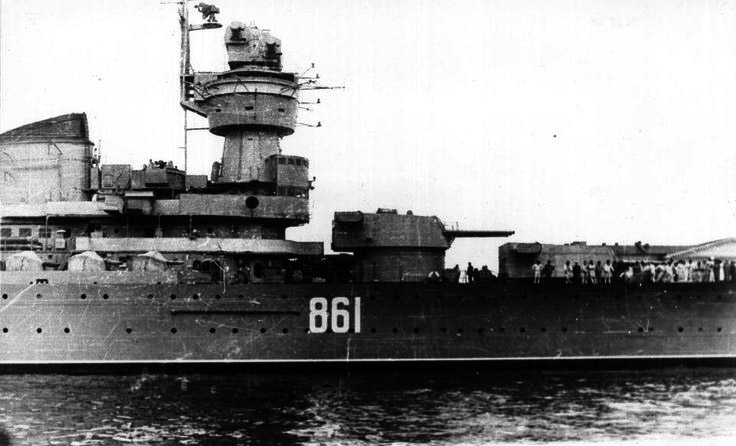
They sacrificed nominal firepower (150 mm guns instead of 180 mm), to integrate an additional turret, carrying three more guns, to go for a twelve guns battery, as for the American ships of the Cleveland class. However, in category, they rank undoubtedly in the “heavy” class, and even near the top of it.
They were well served by a powerful AAA, according to wartime lessons, were further modified along the way to reach more firepower. Secondary armament consisted of eight traditional twin mounts giving way ultimately to four twin turrets, 130 mm caliber, reaching the Soviet fleet standards of 1960.
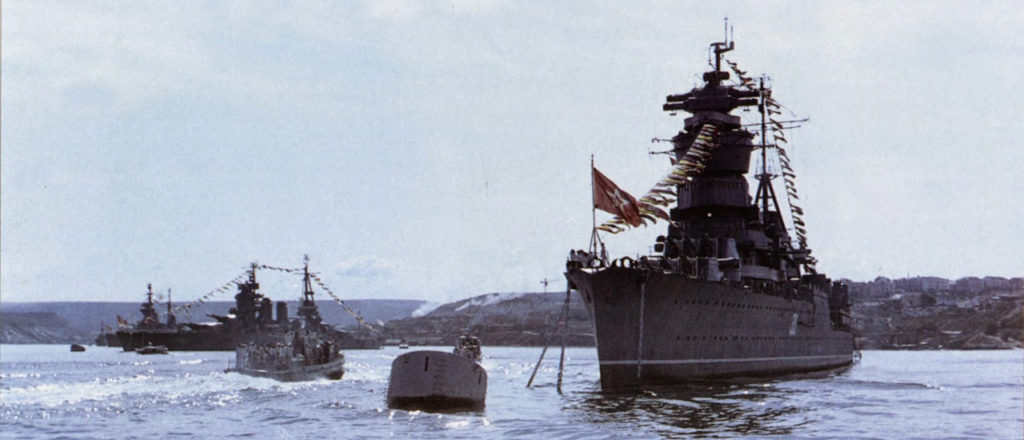
Postwar completion and service of the Chapayev class
Although development of Project 68 started in 1938, the Great Patriotic War freezed all ambitious Soviet naval programs, scheduled for completion in 1943-44. According to the TTZ, the Chapayev class were to be part of a squadron, cover the withdrawing of light forces during an attack, supporting ship patrols and making reconnaissance sweeps, as well as protecting the squadron from light enemy forces, and this included AA cover.
During the war, the shortcomings of the Kirov class cruisers became clear, notably unreliable anti-aircraft armament, outdated artillery fire control, insufficient communications and the lack of radar and hydroacoustics for ASW warfare, as well the use of open combat posts. The naval staff concluded that Project 68 needed a drastic modernization, and this request was originally issued in March 1944. But only in April 1945, TsKB-17 received a detailed specification book for adjusting the design to new the request. This development primarily affected anti-aircraft weaponry and associated guiding systems, as well as radars as a whole.
In order to balance the additional load required in the design modernization called Proyekt 68K, it was decided to abandon both the onboard aviation and associated equipments, as well as the 12.7 mm heavy machine guns considered obsolete when facing the first jets. This did not produce significant results as some tactical and technical elements deteriorated simultaneously with the load increase. The crew also increased, leading to degrading living conditions, in particular the traditional bunks were replaced by three-tiered bunks. In the end, to cram the additional personal and correct possible stability issues it was decided to sacrifice some original features, such as the torpedo tubes and torpedo stores, the paravanes, the ASW grenade launchers, and even reduce the number of 37 mm to 28, as well as many other detail changes.
Taking into account also the deterioration of shipbuilding quality, with skilled personal missing from the yard, it was proposed to complete only five of these pre-war cruisers on the modified 68K project, but to built as a second phase seven more ships according to the Sverdlov 68-bis project, starting in 1949: No less than 18 light cruisers keels were laid down according to project 65 validated by the TTZ, for which was issued in September 1945 already a specific order. The Project 65 existed in two versions originally, with 152 (6-in) and 180 mm (7.5 in) artillery. However in 1947, Stalin ordered personally to concentrate only on 6-in caliber, only suitable for light cruisers, and force the completion of the project 68K cruisers in every possible way. The new Project 65 was delayed, and later cancelled, freeing up the personal to complete the the project 68-bis (Sverdlov) and develop the preliminary design of Proyekt 82.
This decisions allowed the program to go forward despite massive difficulties, and last and fifth cruiser of the project 68-K entered service in 1959, so six years after the death of Stalin, which put an end to all the other conventional ships design. These vessels saw service for the duration of the early part of the cold war. They were discarded in the 1960s, contrary to their successors the Sverdlov class, which for some were still in service at the end of the cold war, mostly for training, as was Komsomolets, withdrawn from the fleet in 1979 after being used as a schoolship. Here is following a detailed account of the ship’s career:
ZHELEZNYAKOV:
Laid down on 31.10.1939 at Shipyard No. 194, mothballed after launch on 10.9.1941 and completed in April 19, 1950 (or July 29, 1950), entering service with the 4th Fleet on 7 September 1950. By 07/30/1951 she was transferred to the Black sea Fleet on 7/8/1968, and transferred to Leningrad district. From 28.5.1973 she was transferred to the Baltic Fleet. From 10/14/1957 to 05/08/1961 she underwent overhaul in Leningrad. From April 18, 1961, she was withdrawn from the Navy and reclassified as a training ship for air suveillance radar operators, and was disarmed and discarded from the Navy on October 21, 1971, stricken on 03/15/1976, and BU in 1976-77 at the Glavvtorchermet base in Liepaja.
KUIBYSHEV:
Laid down on 31.8.1939 at Shipyard No. 200, launched 31 January 1941, from 14.8.1941 she was towed from Nikolaev to Poti and mothballed for the duration of the war. Completed and commissioned in April 20, 1950 (or July 29, 1950), she became a part of the Northern Fleet on 6.8.1950. By April 18, 1958, she was withdrawn from the Navy and reclassified as as a training ship for air surveillance radar operators, disarmed and discarded on April 24, 1965; From 20.12.1965 she was sold for BU, scrapped at Glavvtorchermet base in Sevastopol.
CHAPAYEV:
She was Laid down on 8.10.1939 at Shipyard No. 189 but mothballed after launch on 10.9.1941 and completed on May 16, 1950 (or May 27, 1950), entered the 4th Fleet on 19.9.1950. In 07/30/1951 she transferred to the Black sea fleet and on April 18, 1958, was withdrawn from the Navy’s active fleet, and reclassified as training ship for air surveillance radar operators, disarmed and reclassed as PKZ on 6.2.1960. Discarded and stricken on 12.4.1963 she was sold on October 29, 1963, and from 1964 BU at Glavvtorchermet facility of Murmansk.
CHKALOV:
Laid down on 31.8.1939 at Shipyard No. 189 and mothballed after launch in September 1941, she was relaunched on 10/25/1947, completed and commissioned in 10/25/1950. She was transferred to the 8th fleet on April 22, 1951. From 12/24/1955 she transferred to the Baltic. She was renamed on 29.10.1958 “KOMSOMOLETS”. In May 1973, she was transferred to Leningrad district and on 01/28/1976 to the Baltic again. She was discarded on September 27, 1979 and in 1980 BU by the Glavvtorchermet facility in Liepaja.
FRUNZE:
Laid down on 08/29/1939 at Shipyard No. 198, she was launched and on 9.8.1941 towed to Poti to be mothballed until 1942. There, her stern was detached and welded to the hull of the damaged cruiser Molotov (project 26-bis). She was completed and commissioned on 19.12.1950 (or 28.3.1951), Northern fleet fromn 8.4.1951. On April 18, 1958, she was withdrawn and reclassified as a training radar ship, disarmed and stricken on 6.2.1960, sold and BU in 1960-61 at Glavvtorchermet Sevastopol.
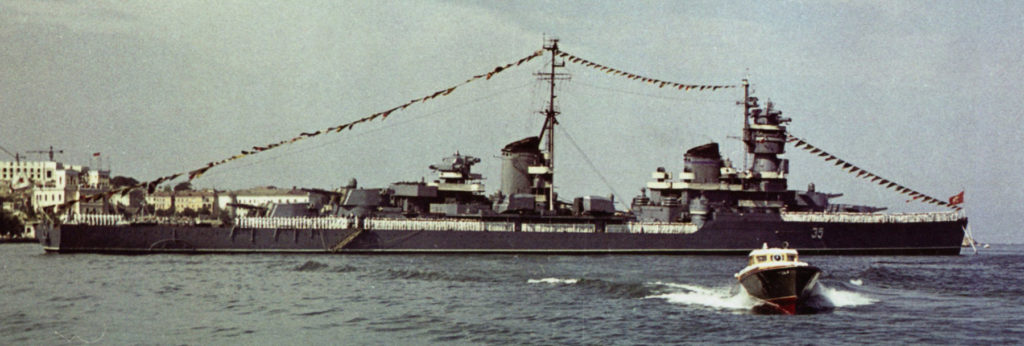
Kuybishev in 1954, 25 July Navy Day at Sevastopol. The ships were equipped to carry and lay more than 200 mines. The equipments were removed bu theyr kept their railings until the end of their service.
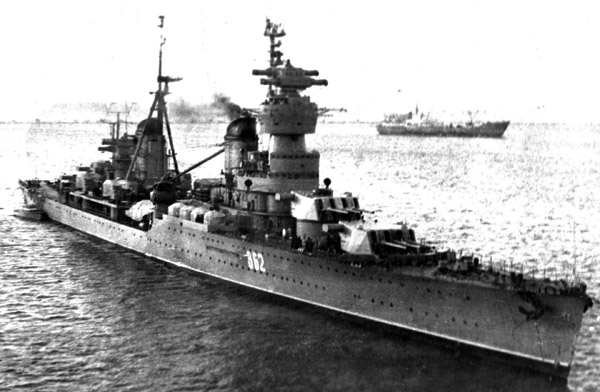
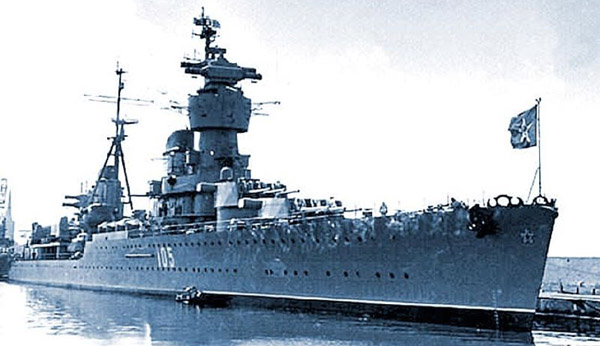
Chapayev class cruisers were in service in 1960. However the dates were they were stricken from the fleet list is unknown: Chapayev is believed to have been retired 1961, as Frunze or 1962, and the Kuibyshev. Chkalov and Zhelezniakov were however maintained in service until 1990 as training ships. With the decomposition of the Soviet Union, no doubt they were mothballed and left to rot. None was preserved.

Komsomolec, of the Chapayev class
Specifications
Displacement: 11,300t, 15,000t FL
Dimensions: 201 x 19.70 x 6.40m
Propulsion: 2 turbines , 6 boilers, 130 000 hp = 34 Knots
Crew: 840
Armour: 50 – 80 mm (3.8 in), blockhaus 152 mm (6 in).
Weaponry: 18 x 150 (6 in) (4×3), 8 x 2 AA 100 mm (4.6 in), 24 x 37 mm, 6 533 mm TTs (21 in) (2×3).

The next Sverdlov class.
Read More/Src
Conway’s All the World’s Fighting Ships 1947-1995
Conway’s All the World’s Fighting Ships 1922-1946
http://ship.bsu.by/ship/102259
http://www.navweaps.com/Weapons/WNRussian_Main.php
https://www.navypedia.org/ships/russia/ru_cr_chapaev.htm
https://en.wikipedia.org/wiki/Chapayev-class_cruiser
Cruiser “Frunze, Kuybishev” from Black Sea Fleet (in Russian, with photos)
http://ship.bsu.by/main.asp?id=102259
Jarovoj, V. V.; Greger, René (1994). “The Soviet Cruisers of the Chapayev and Sverdlov classes”. Warship 1994.
MJ Whitley – Cruisers of World War 2, an International Encyclopedia, Arms & Armour Press
All Russian Chapayev Class Cruisers – Complete Ship List


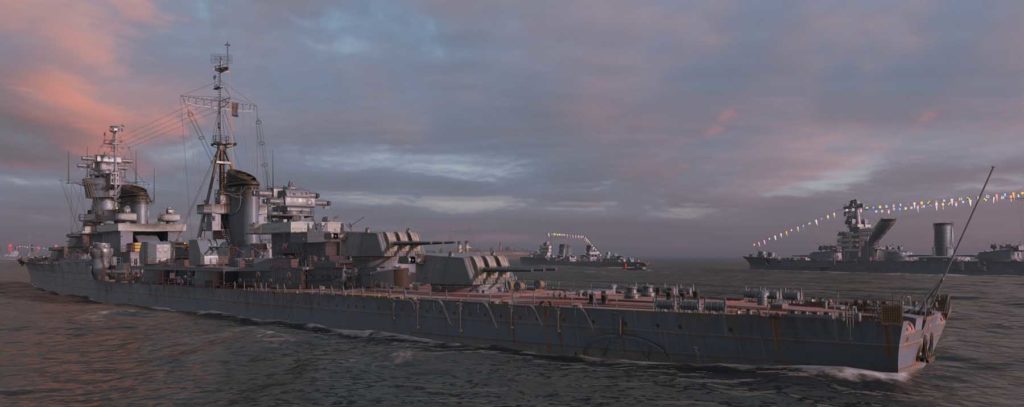

 Latest Facebook Entry -
Latest Facebook Entry -  X(Tweeter) Naval Encyclopedia's deck archive
X(Tweeter) Naval Encyclopedia's deck archive Instagram (@navalencyc)
Instagram (@navalencyc)





 French Navy
French Navy Royal Navy
Royal Navy Russian Navy
Russian Navy Armada Espanola
Armada Espanola Austrian Navy
Austrian Navy K.u.K. Kriegsmarine
K.u.K. Kriegsmarine Dansk Marine
Dansk Marine Nautiko Hellenon
Nautiko Hellenon Koninklije Marine 1870
Koninklije Marine 1870 Marinha do Brasil
Marinha do Brasil Osmanlı Donanması
Osmanlı Donanması Marina Do Peru
Marina Do Peru Marinha do Portugal
Marinha do Portugal Regia Marina 1870
Regia Marina 1870 Nihhon Kaigun 1870
Nihhon Kaigun 1870 Preußische Marine 1870
Preußische Marine 1870 Russkiy Flot 1870
Russkiy Flot 1870 Svenska marinen
Svenska marinen Søværnet
Søværnet Union Navy
Union Navy Confederate Navy
Confederate Navy Armada de Argentina
Armada de Argentina Imperial Chinese Navy
Imperial Chinese Navy Marinha do Portugal
Marinha do Portugal Mexico
Mexico Kaiserliche Marine
Kaiserliche Marine 1898 US Navy
1898 US Navy Sovietskiy Flot
Sovietskiy Flot Royal Canadian Navy
Royal Canadian Navy Royal Australian Navy
Royal Australian Navy RNZN Fleet
RNZN Fleet Chinese Navy 1937
Chinese Navy 1937 Kriegsmarine
Kriegsmarine Chilean Navy
Chilean Navy Danish Navy
Danish Navy Finnish Navy
Finnish Navy Hellenic Navy
Hellenic Navy Polish Navy
Polish Navy Romanian Navy
Romanian Navy Turkish Navy
Turkish Navy Royal Yugoslav Navy
Royal Yugoslav Navy Royal Thai Navy
Royal Thai Navy Minor Navies
Minor Navies Albania
Albania Austria
Austria Belgium
Belgium Columbia
Columbia Costa Rica
Costa Rica Cuba
Cuba Czechoslovakia
Czechoslovakia Dominican Republic
Dominican Republic Haiti
Haiti Hungary
Hungary Honduras
Honduras Estonia
Estonia Iceland
Iceland Eire
Eire Equador
Equador Iran
Iran Iraq
Iraq Latvia
Latvia Liberia
Liberia Lithuania
Lithuania Mandchukuo
Mandchukuo Morocco
Morocco Nicaragua
Nicaragua Persia
Persia San Salvador
San Salvador Sarawak
Sarawak Uruguay
Uruguay Venezuela
Venezuela Zanzibar
Zanzibar Warsaw Pact Navies
Warsaw Pact Navies Bulgaria
Bulgaria Hungary
Hungary

 Bundesmarine
Bundesmarine Dutch Navy
Dutch Navy Hellenic Navy
Hellenic Navy Marina Militare
Marina Militare Yugoslav Navy
Yugoslav Navy Chinese Navy
Chinese Navy Indian Navy
Indian Navy Indonesian Navy
Indonesian Navy JMSDF
JMSDF North Korean Navy
North Korean Navy Pakistani Navy
Pakistani Navy Philippines Navy
Philippines Navy ROKN
ROKN Rep. of Singapore Navy
Rep. of Singapore Navy Taiwanese Navy
Taiwanese Navy IDF Navy
IDF Navy Saudi Navy
Saudi Navy Royal New Zealand Navy
Royal New Zealand Navy Egyptian Navy
Egyptian Navy South African Navy
South African Navy






























 Ukrainian Navy
Ukrainian Navy dbodesign
dbodesign